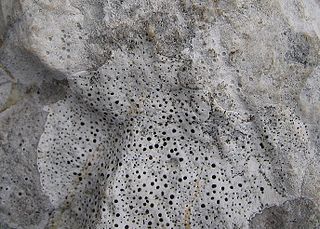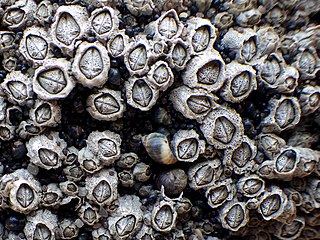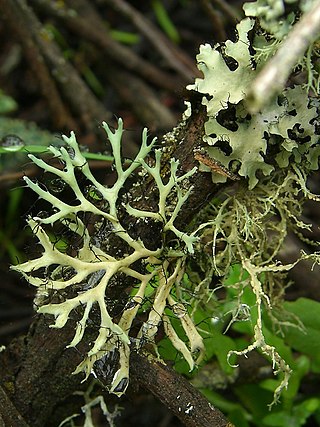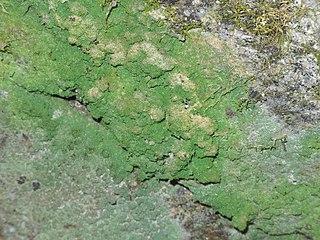
The Parmeliaceae is a large and diverse family of Lecanoromycetes. With over 2700 species in 71 genera, it is the largest family of lichen-forming fungi. The most speciose genera in the family are the well-known groups: Xanthoparmelia, Usnea, Parmotrema, and Hypotrachyna.

The Physciaceae are a family of mostly lichen-forming fungi belonging to the class Lecanoromycetes in the division Ascomycota. A 2016 estimate placed 19 genera and 601 species in the family.

Verrucariales is an order of ascomycetous fungi within the subclass Chaetothyriomycetidae of the class Eurotiomycetes. Although most of the Verrucariales are lichenised, the family Sarcopyreniaceae consists of 11 species of lichenicolous (lichen-dwelling) fungi.

Anaptychia is a genus of lichen-forming fungi in the family Physciaceae.

Pyxine is a genus of foliose lichens in the family Caliciaceae. The genus has a widespread distribution in tropical regions.

Physconia is a genus of lichen-forming fungi in the family Physciaceae. It has about 25 species. The genus was circumscribed by Czech lichenologist Josef Poelt in 1965, with Physconia pulverulenta assigned as the type species.
Santessonia is a genus of lichenized fungi in the family Caliciaceae. The genus was circumscribed in 1978 by lichenologists Mason Hale and Gernot Vobis, with Santessonia namibensis assigned as the type species, and at that time, only species. This species, endemic to the Namib Desert, has deep depressions (lacunae) in the thallus, which are interpreted as an adaptation to take advantage of the infrequent moisture provided by fog. The genus name honours Norwegian lichenologist Rolf Santesson.

Parmelina is a genus of lichen belonging to the family Parmeliaceae. The genus was circumscribed in 1974 by American lichenologist Mason Hale with Parmelina tiliacea assigned as the type species.

Xanthopyreniaceae is a family of lichen-forming fungi in the order Collemopsidiales. The family was circumscribed by lichenologist Alexander Zahlbruckner in 1926.

The Caliciaceae are a family of mostly lichen-forming fungi belonging to the class Lecanoromycetes in the division Ascomycota. Although the family has had its classification changed several times throughout its taxonomic history, the use of modern molecular phylogenetic methods have helped to establish its current placement in the order Caliciales. Caliciaceae contains 36 genera and about 600 species. The largest genus is Buellia, with around 300 species; there are more than a dozen genera that contain only a single species.

Protoparmelia is a genus of lichenized fungi in the family Parmeliaceae. The genus has a widespread distribution, and contains 11 species. Protoparmelia was circumscribed by French lichenologist Maurice Choisy in 1929.
Austromelanelixia is a genus of five species of foliose lichens in the family Parmeliaceae. All species are found in the Southern Hemisphere.
John Alan (Jack) Elix emeritus professor in chemistry at the Australian National University, is an organic chemist who has contributed in many fields: lichenology, lichen chemotaxonomy, plant physiology and biodiversity and natural product chemistry. He has authored 2282 species names, and 67 genera in the field of mycology.

Caliciales is an order of mostly lichenized fungi in the class Lecanoromycetes. It consists of two families: Caliciaceae and Physciaceae, which together contain 54 genera and more than 1200 species. The order was circumscribed by American botanist Charles Edwin Bessey in 1907.
Endohyalina is a genus of 10 species of corticolous lichens in the family Caliciaceae. The genus was circumscribed by Bernhard Marbach in 2000, with Endohyalina rappii designated as the type species.

Polyblastidium is a genus of foliose lichens in the family Physciaceae. It has 18 species. The genus was circumscribed by German lichenologist Klaus Kalb in 2015, with Polyblastidium japonicum assigned as the type species. Polyblastidium is similar in morphology to Heterodermia, but its lower surface is cobweb-like in structure (arachnoid), and its ascospores are mostly 1-septate with 1 to 3 sporoblastidia. It is this latter feature that is referenced in the genus name Polyblastidium. The genus contains several species that were formerly classified in the genus Anaptychia.

Leucodermia is a genus of lichen-forming fungi in the family Physciaceae.

Botryolepraria is a genus of saxicolous (rock-dwelling), byssoid (cottony) lichens of uncertain familial placement in the order Verrucariales. It has two species. Both species grow in damp conditions, such as on cave walls, particularly in areas with minimal light.
Kashiwadia is a genus of lichen-forming fungi in the family Physciaceae. The genus was circumscribed in Sergey Kondratyuk, László Lőkös, and Jae-Seoun Hur in 2014 to contain the species Physcia orientalis, after molecular phylogenetic analysis showed that the taxon occupied an isolated phylogenetic position in the Physciaceae. An additional five species were added to the genus in 2021. The genus name honours Japanese lichenologist Hiroyuki Kashiwadani, who originally described the type species.













